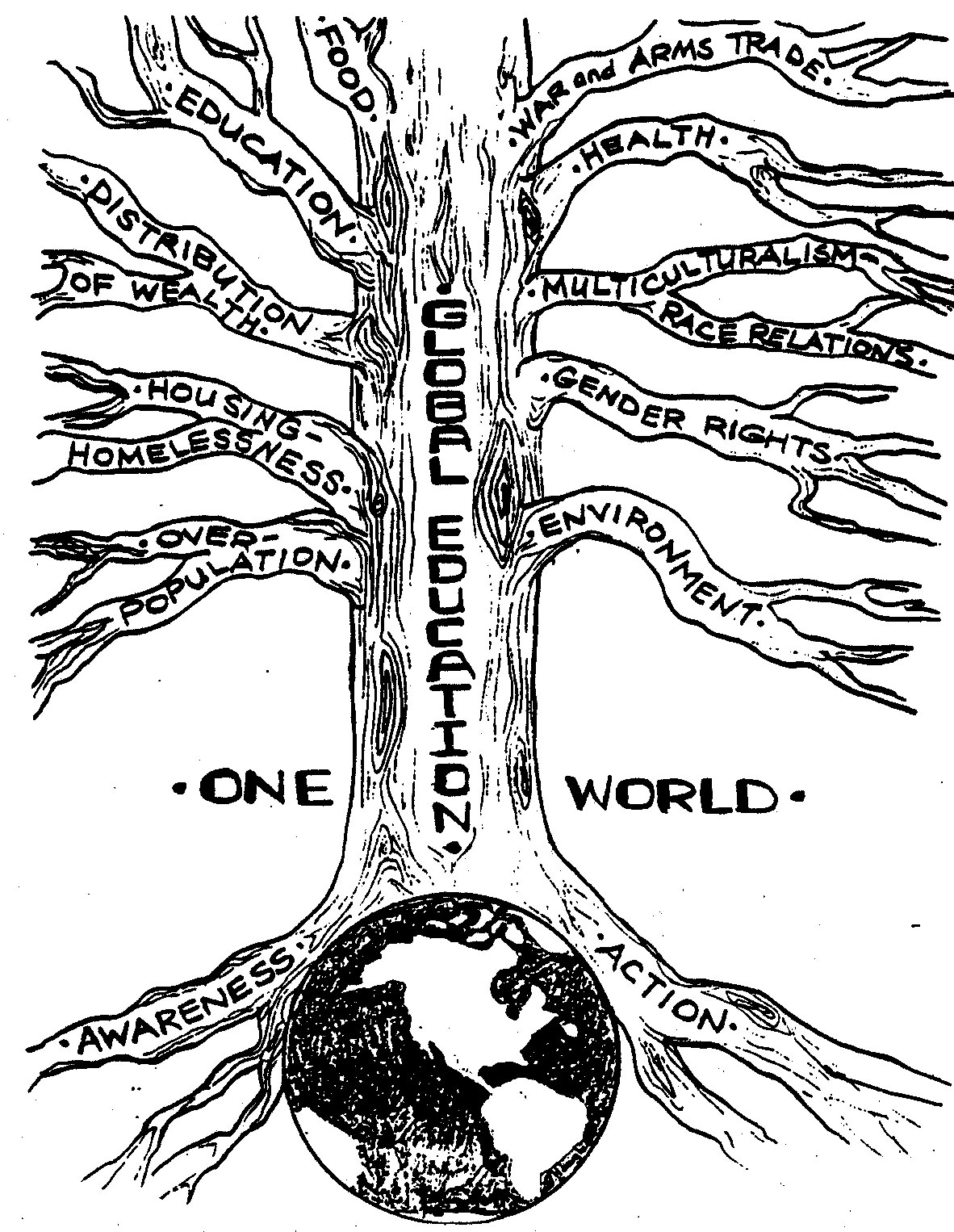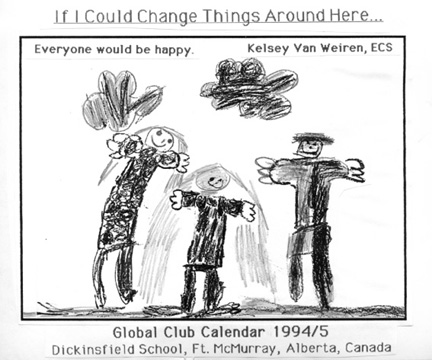 The
Global Education Club
The
Global Education Club The
Global Education Club
The
Global Education Club
What Are Global Problems?
"Never
doubt that a small group of thoughtful, committed citizens can change the world;
indeed, it's the only thing that ever does." Margaret Mead

Glenda Haughian, a teacher with Ft. McMurray Public School District, drew this tree. It shows some of our world's most pressing problems. There are others of course, including child labour, violence, disabilities, and support of the aged. Many of the problems are interconnected. For example if a family does not have enough income, in many countries their children will need to work. This will keep the children from being able to go to school. This keeps them from gaining the knowledge and skills to improve their income in the future.
|
Basic Human Needs |
A Global Problem is when our basic needs aren't met. We
all need (and have a right to); 
education
These are entrenched in the United Charter of Human
Rights. Whatever keeps us from getting these needs met is a Global Problem.
Every community in the world has these problems, including ours and yours. Some countries and communities have more problems than others at certain times. People create these problems. And people can solve these problems.
Fixing the problems comes through awareness and action. The problems can be solved. Look back in history, and think of the progress we have made in ending so many problems, such as slavery and apartheid. Everyone can help. When we help others, we are helping ourselves. We have the right, and the responsibility to have a happy, healthy planet and global community.
It can seem like the problems are huge. But carry on and see how we have done hundreds of small things that together make a big difference.
|
One Small World |
The following was prepared by
Phillip M. Harter, MD, Stanford University, School of Medicine:
If we could shrink the world's population to a village of precisely 100 people,
with all the existing human ratios remaining the same, it would looking
something like the following:
THERE WOULD BE:
57 Asians
21 Europeans
14 from teh Western Hemisphere, both North & South America
8 Africans
52 would be female
48 would be male
70 would be non-white
30 would be white
70 would be non-Christian
30 would be Christian
89 would be heterosexual
11 would be homosexual
6 people would possess 59% of the
entire world's wealth
and all 6 would be from the United States
80 would live in substandard housing
70 would be unable to read
50 would suffer from malnutrition
1 would be near death
1 would be near birth
1 (yes only 1) would have a college education
1 would own a computer
When one considers our world from such a compressed perspective, the need for both acceptance, understanding and education becomes glaringly apparent.
|
Some Facts |
Here are a few sample statistics from a United Nations Fact Sheet
Violence against women and girls is the most
pervasive violation of human rights in the world today.
SOURCE:
The Progress of Nations
1997, UNICEF
Discrimination against women and girls is an
important basic cause of malnutrition. The very high rates of child malnutrition
and low birth weight throughout much of South Asia are linked to such factors as
women's poor access to education and their low levels of participation in paid
employment, compared with other regions.
SOURCE:
The State of the World's
Children 1998, UNICEF
More than 1 million children, mostly girls, are
forced into prostitution every year.
SOURCE:
The Progress of Nations
1997, UNICEF
Disabled persons constitute ten per cent of the world’s population.
SOURCE:
World
Programme of Action Concerning Disabled Persons
79 per cent of the indigenous people in Peru are
poor, and more than half live in extreme poverty.
SOURCE:
Indigenous people:
Challenges facing the international community
Some 250 million children between the ages of 5
and 14 are currently working, according to the International Labour Office (ILO).
Of this total, some 120 million children are working full-time. Some 61% of
child workers (153 million) are found in Asia; 32% in Africa and 7% in Latin
America.
SOURCE:
Dossier on Child Labour, UNESCO Education International quarterly
magazine, September 1997
2 million girls each year are at risk of genital
mutilation - approximately 6,000 per day.
SOURCE:
The Progress of Nations
1997, UNICEF
Some 160 million children are moderately or severely malnourished. Some 110
million are out of school.
SOURCE:
UNDP Human Development Report, 1997
http://www.undp.org/hdro/
At least 500,000 children a year are left motherless by death in childbirth.
SOURCE:
UNDP Human Development Report, 1997
http://www.undp.org/hdro/
Over 1.3 billion people in developing countries make ends meet with less than 1
dollar per day.
SOURCE:
UNDP Human Development Report, 1997
http://www.undp.org/hdro/
Women comprise 70% of the world's poor.
SOURCE:
Information Kit, Decade for the Eradication of Poverty 1997-2006, UNDP
For more information on the issues, check the "Resources" section of this website.

Mrs. Marcellus and her children coordinate our school's Unicef boxes each Halloween, and once a year they set up a dead tree in the front foyer. Students donate a loonie to put a paper leaf or ribbon on the tree. The proceeds are donated to a worthy cause (Hurricane Mitch relief, 911 help for children in Iraq...) As the tree is covered with leaves, it becomes beautiful and symbol of hope and action.
|
The Global
Education Club
Website
E-mail contact: kathleen.cochrane@fmpsd.ab.ca Check out Kitty's other webs at www.kittycochrane.ca
|